Marketing Analysis: Kids Tablet and Entertainment Content Strategies
VerifiedAdded on 2022/09/12
|12
|2727
|14
Report
AI Summary
This report analyzes marketing strategies for a kids' tablet and entertainment content, targeting children aged 6-10. It begins by defining the target market's characteristics, needs, and the importance of digital products and entertainment. The product, a kids' tablet with e-learning and entertainment content, is then detailed, emphasizing the need for learning, entertainment, and adventure. The report outlines a basic marketing message, including the use of 'learning, entertainment, and adventure' keywords, and explains how the tablet satisfies market needs through categorized content and continuous updates. It also explores effective marketing channels like television and online platforms, followed by a comprehensive 7Ps marketing mix analysis, including product strategy, pricing, promotion, place/distribution, people, physical evidence, and process. The report concludes by summarizing the key elements of a successful marketing strategy for this target market, emphasizing differentiation, value-based pricing, integrated promotion, and efficient distribution and customer support.
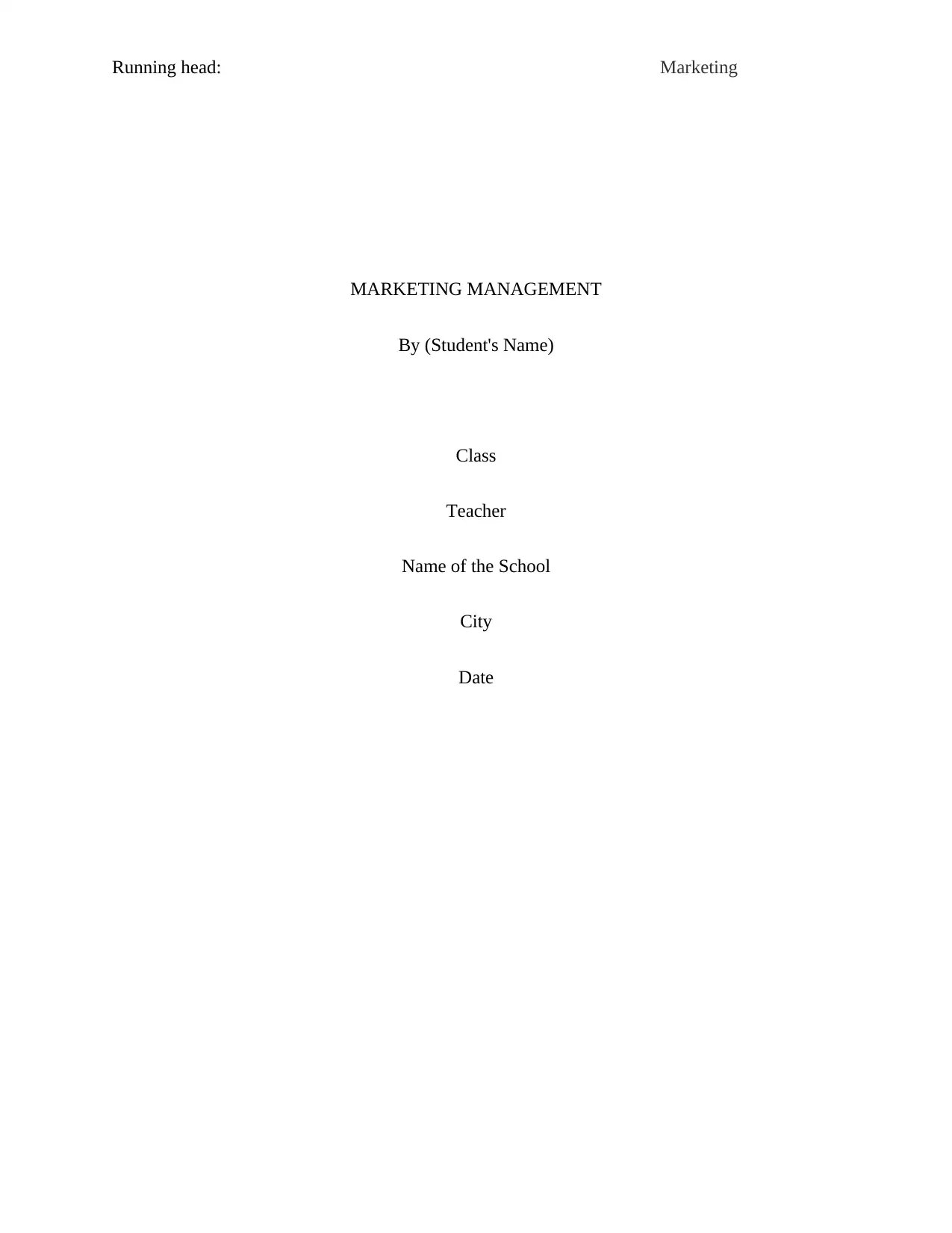
Running head: Marketing
MARKETING MANAGEMENT
By (Student's Name)
Class
Teacher
Name of the School
City
Date
MARKETING MANAGEMENT
By (Student's Name)
Class
Teacher
Name of the School
City
Date
Paraphrase This Document
Need a fresh take? Get an instant paraphrase of this document with our AI Paraphraser
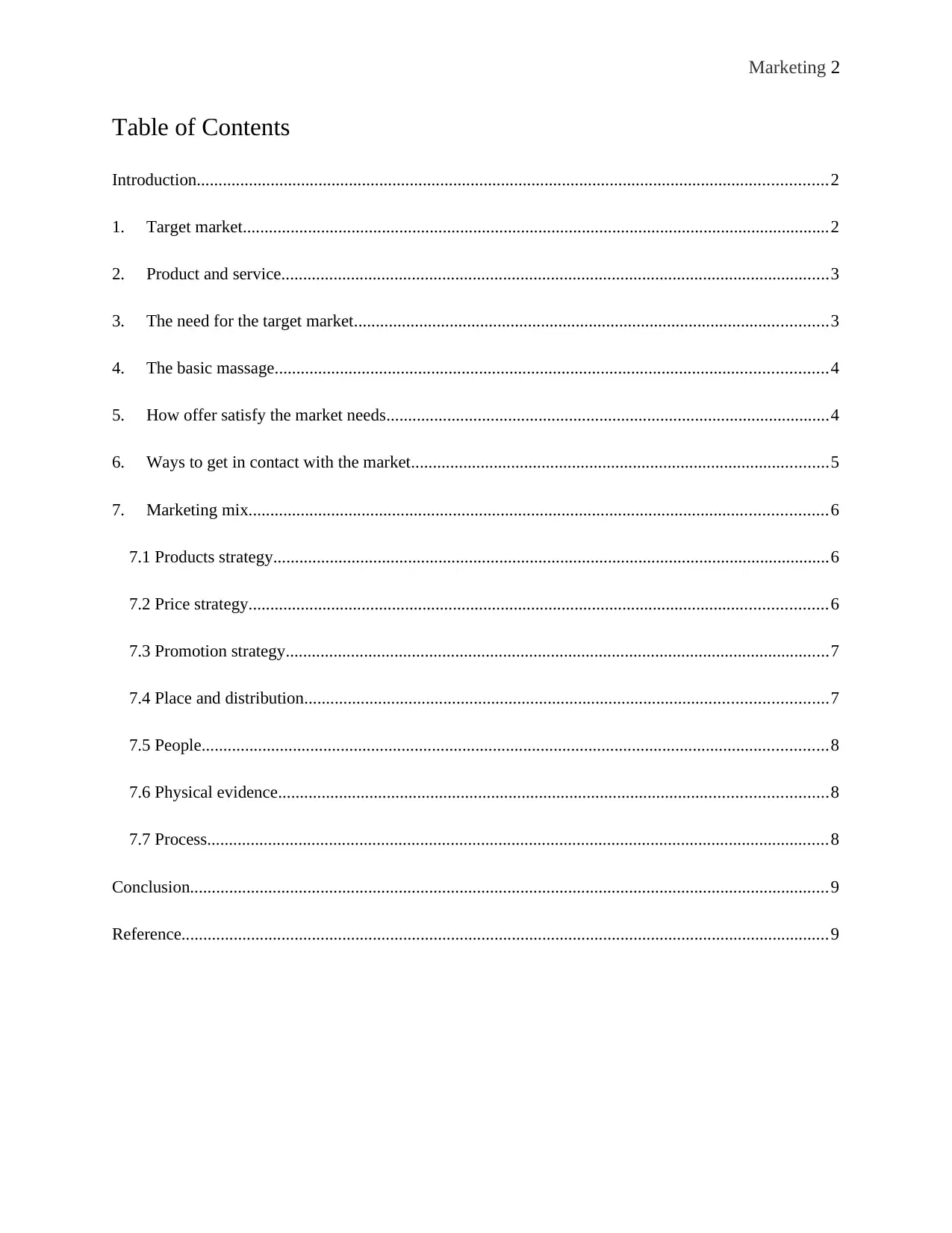
Marketing 2
Table of Contents
Introduction.................................................................................................................................................2
1. Target market.......................................................................................................................................2
2. Product and service..............................................................................................................................3
3. The need for the target market.............................................................................................................3
4. The basic massage...............................................................................................................................4
5. How offer satisfy the market needs......................................................................................................4
6. Ways to get in contact with the market................................................................................................5
7. Marketing mix.....................................................................................................................................6
7.1 Products strategy................................................................................................................................6
7.2 Price strategy.....................................................................................................................................6
7.3 Promotion strategy.............................................................................................................................7
7.4 Place and distribution........................................................................................................................7
7.5 People................................................................................................................................................8
7.6 Physical evidence..............................................................................................................................8
7.7 Process...............................................................................................................................................8
Conclusion...................................................................................................................................................9
Reference.....................................................................................................................................................9
Table of Contents
Introduction.................................................................................................................................................2
1. Target market.......................................................................................................................................2
2. Product and service..............................................................................................................................3
3. The need for the target market.............................................................................................................3
4. The basic massage...............................................................................................................................4
5. How offer satisfy the market needs......................................................................................................4
6. Ways to get in contact with the market................................................................................................5
7. Marketing mix.....................................................................................................................................6
7.1 Products strategy................................................................................................................................6
7.2 Price strategy.....................................................................................................................................6
7.3 Promotion strategy.............................................................................................................................7
7.4 Place and distribution........................................................................................................................7
7.5 People................................................................................................................................................8
7.6 Physical evidence..............................................................................................................................8
7.7 Process...............................................................................................................................................8
Conclusion...................................................................................................................................................9
Reference.....................................................................................................................................................9
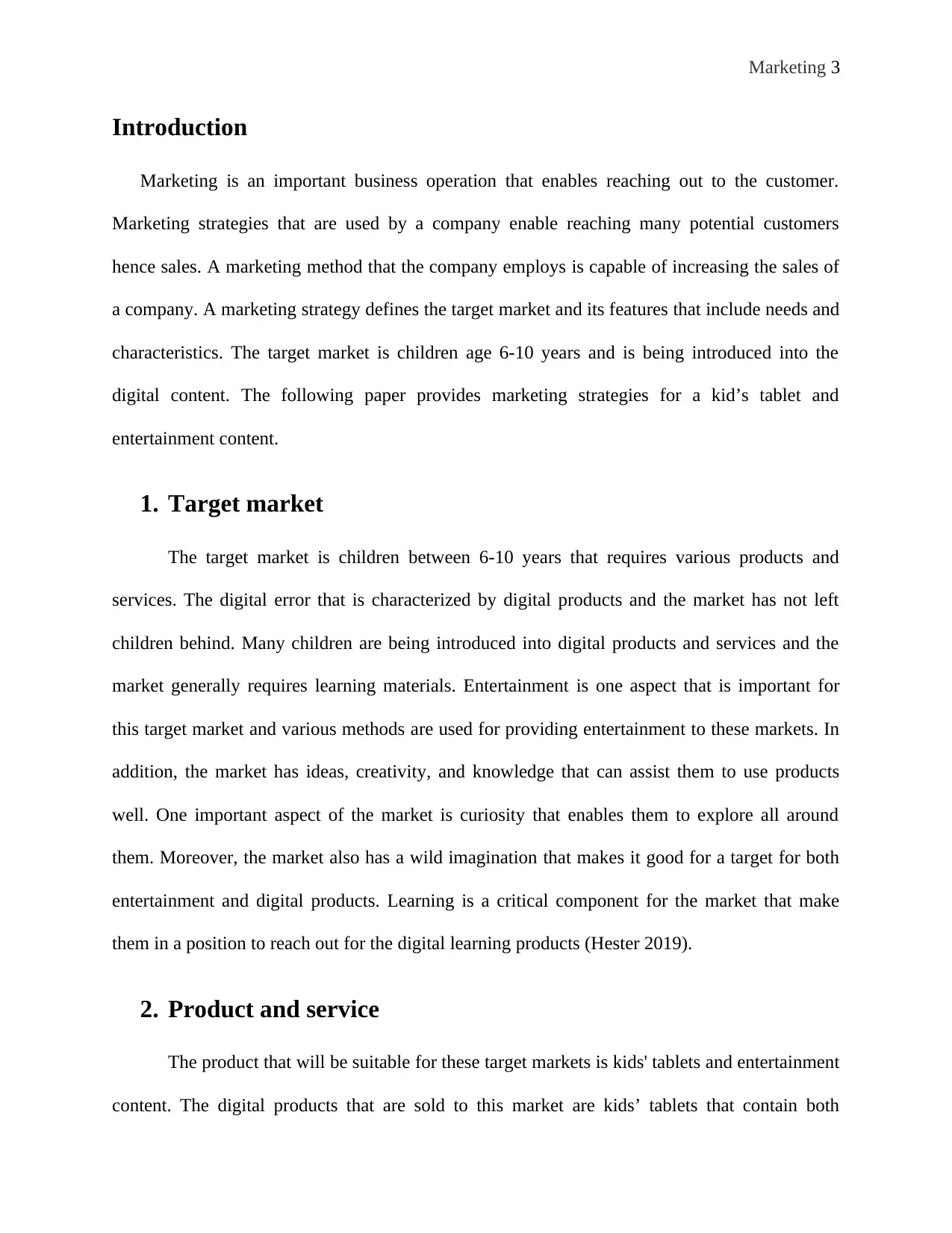
Marketing 3
Introduction
Marketing is an important business operation that enables reaching out to the customer.
Marketing strategies that are used by a company enable reaching many potential customers
hence sales. A marketing method that the company employs is capable of increasing the sales of
a company. A marketing strategy defines the target market and its features that include needs and
characteristics. The target market is children age 6-10 years and is being introduced into the
digital content. The following paper provides marketing strategies for a kid’s tablet and
entertainment content.
1. Target market
The target market is children between 6-10 years that requires various products and
services. The digital error that is characterized by digital products and the market has not left
children behind. Many children are being introduced into digital products and services and the
market generally requires learning materials. Entertainment is one aspect that is important for
this target market and various methods are used for providing entertainment to these markets. In
addition, the market has ideas, creativity, and knowledge that can assist them to use products
well. One important aspect of the market is curiosity that enables them to explore all around
them. Moreover, the market also has a wild imagination that makes it good for a target for both
entertainment and digital products. Learning is a critical component for the market that make
them in a position to reach out for the digital learning products (Hester 2019).
2. Product and service
The product that will be suitable for these target markets is kids' tablets and entertainment
content. The digital products that are sold to this market are kids’ tablets that contain both
Introduction
Marketing is an important business operation that enables reaching out to the customer.
Marketing strategies that are used by a company enable reaching many potential customers
hence sales. A marketing method that the company employs is capable of increasing the sales of
a company. A marketing strategy defines the target market and its features that include needs and
characteristics. The target market is children age 6-10 years and is being introduced into the
digital content. The following paper provides marketing strategies for a kid’s tablet and
entertainment content.
1. Target market
The target market is children between 6-10 years that requires various products and
services. The digital error that is characterized by digital products and the market has not left
children behind. Many children are being introduced into digital products and services and the
market generally requires learning materials. Entertainment is one aspect that is important for
this target market and various methods are used for providing entertainment to these markets. In
addition, the market has ideas, creativity, and knowledge that can assist them to use products
well. One important aspect of the market is curiosity that enables them to explore all around
them. Moreover, the market also has a wild imagination that makes it good for a target for both
entertainment and digital products. Learning is a critical component for the market that make
them in a position to reach out for the digital learning products (Hester 2019).
2. Product and service
The product that will be suitable for these target markets is kids' tablets and entertainment
content. The digital products that are sold to this market are kids’ tablets that contain both
⊘ This is a preview!⊘
Do you want full access?
Subscribe today to unlock all pages.

Trusted by 1+ million students worldwide
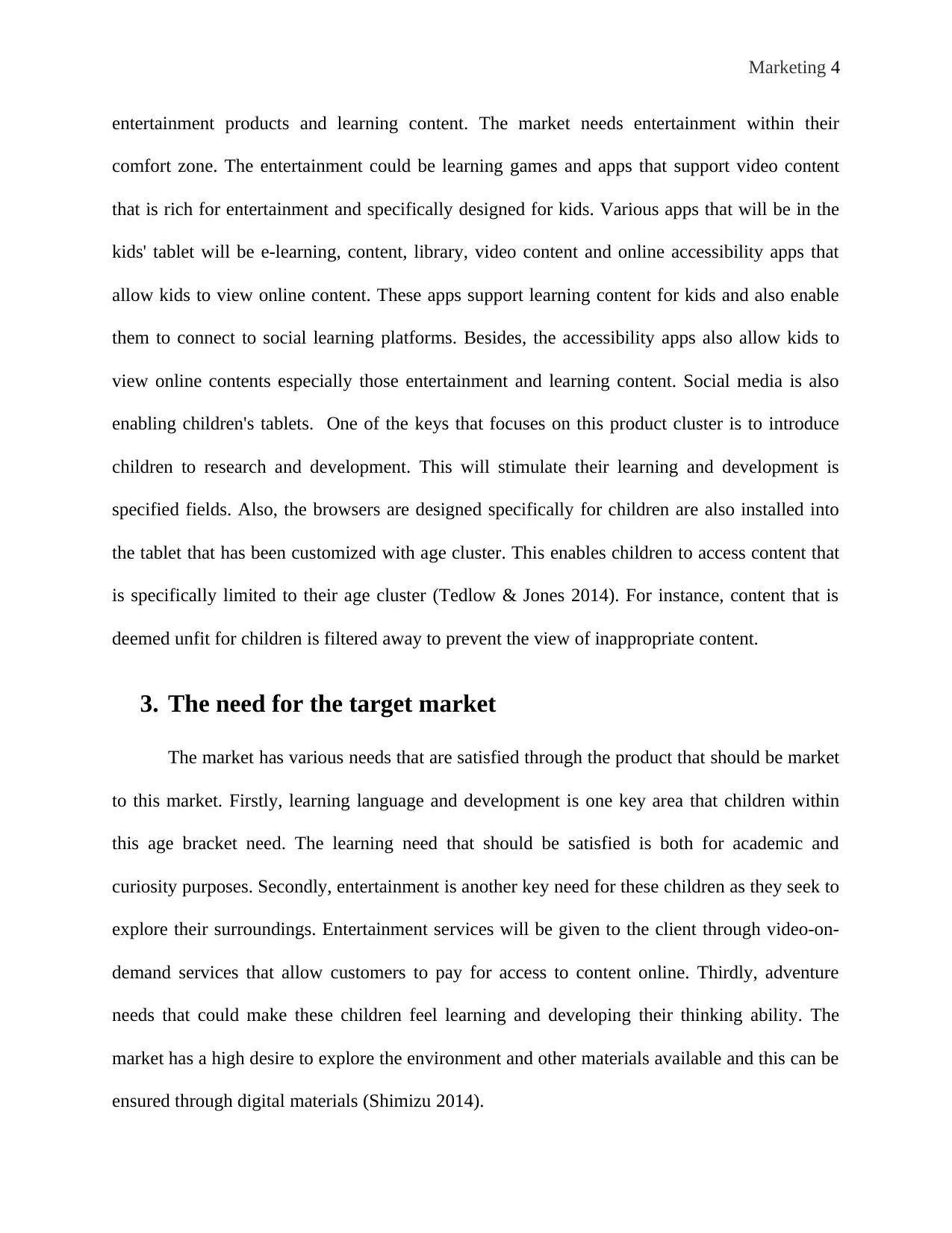
Marketing 4
entertainment products and learning content. The market needs entertainment within their
comfort zone. The entertainment could be learning games and apps that support video content
that is rich for entertainment and specifically designed for kids. Various apps that will be in the
kids' tablet will be e-learning, content, library, video content and online accessibility apps that
allow kids to view online content. These apps support learning content for kids and also enable
them to connect to social learning platforms. Besides, the accessibility apps also allow kids to
view online contents especially those entertainment and learning content. Social media is also
enabling children's tablets. One of the keys that focuses on this product cluster is to introduce
children to research and development. This will stimulate their learning and development is
specified fields. Also, the browsers are designed specifically for children are also installed into
the tablet that has been customized with age cluster. This enables children to access content that
is specifically limited to their age cluster (Tedlow & Jones 2014). For instance, content that is
deemed unfit for children is filtered away to prevent the view of inappropriate content.
3. The need for the target market
The market has various needs that are satisfied through the product that should be market
to this market. Firstly, learning language and development is one key area that children within
this age bracket need. The learning need that should be satisfied is both for academic and
curiosity purposes. Secondly, entertainment is another key need for these children as they seek to
explore their surroundings. Entertainment services will be given to the client through video-on-
demand services that allow customers to pay for access to content online. Thirdly, adventure
needs that could make these children feel learning and developing their thinking ability. The
market has a high desire to explore the environment and other materials available and this can be
ensured through digital materials (Shimizu 2014).
entertainment products and learning content. The market needs entertainment within their
comfort zone. The entertainment could be learning games and apps that support video content
that is rich for entertainment and specifically designed for kids. Various apps that will be in the
kids' tablet will be e-learning, content, library, video content and online accessibility apps that
allow kids to view online content. These apps support learning content for kids and also enable
them to connect to social learning platforms. Besides, the accessibility apps also allow kids to
view online contents especially those entertainment and learning content. Social media is also
enabling children's tablets. One of the keys that focuses on this product cluster is to introduce
children to research and development. This will stimulate their learning and development is
specified fields. Also, the browsers are designed specifically for children are also installed into
the tablet that has been customized with age cluster. This enables children to access content that
is specifically limited to their age cluster (Tedlow & Jones 2014). For instance, content that is
deemed unfit for children is filtered away to prevent the view of inappropriate content.
3. The need for the target market
The market has various needs that are satisfied through the product that should be market
to this market. Firstly, learning language and development is one key area that children within
this age bracket need. The learning need that should be satisfied is both for academic and
curiosity purposes. Secondly, entertainment is another key need for these children as they seek to
explore their surroundings. Entertainment services will be given to the client through video-on-
demand services that allow customers to pay for access to content online. Thirdly, adventure
needs that could make these children feel learning and developing their thinking ability. The
market has a high desire to explore the environment and other materials available and this can be
ensured through digital materials (Shimizu 2014).
Paraphrase This Document
Need a fresh take? Get an instant paraphrase of this document with our AI Paraphraser
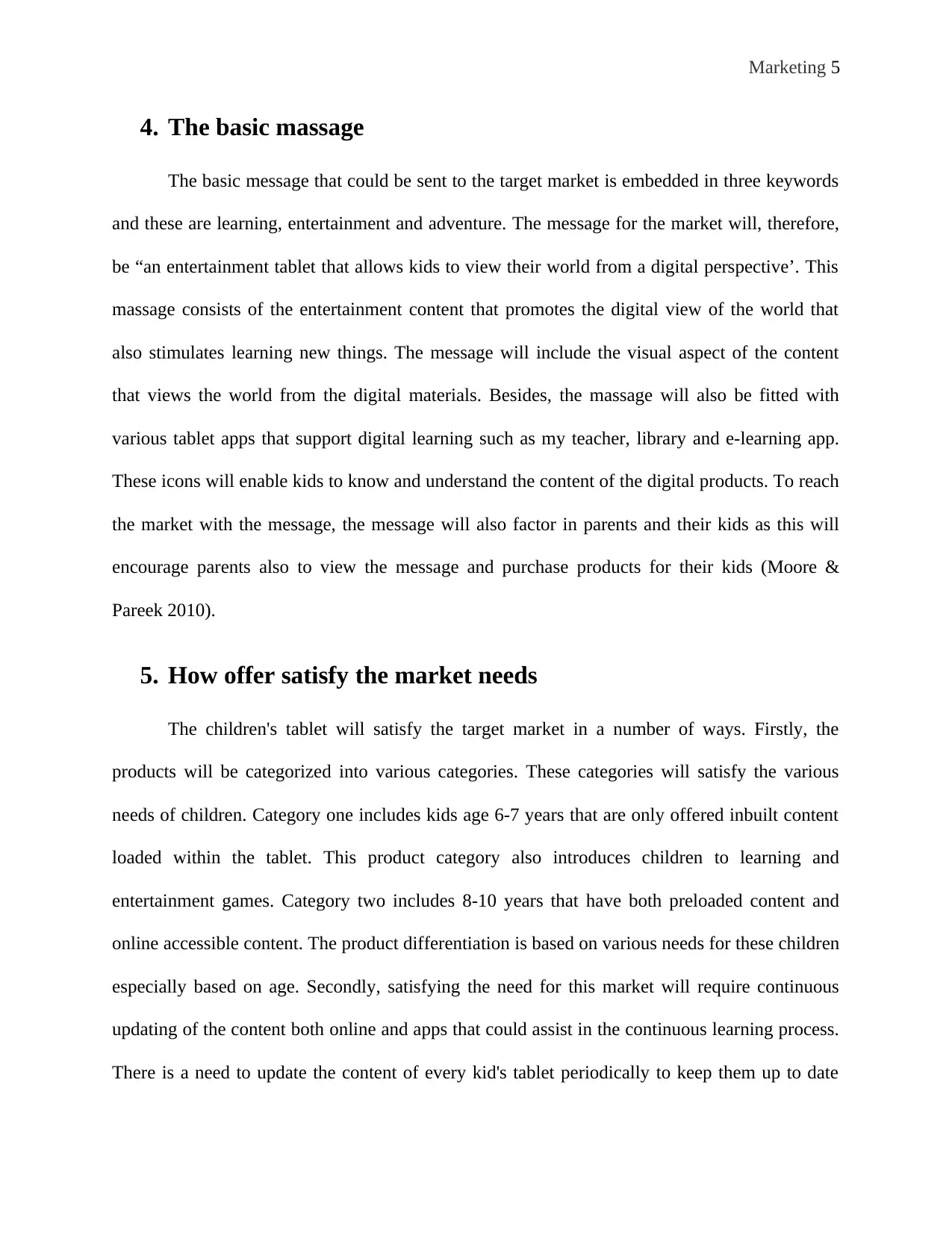
Marketing 5
4. The basic massage
The basic message that could be sent to the target market is embedded in three keywords
and these are learning, entertainment and adventure. The message for the market will, therefore,
be “an entertainment tablet that allows kids to view their world from a digital perspective’. This
massage consists of the entertainment content that promotes the digital view of the world that
also stimulates learning new things. The message will include the visual aspect of the content
that views the world from the digital materials. Besides, the massage will also be fitted with
various tablet apps that support digital learning such as my teacher, library and e-learning app.
These icons will enable kids to know and understand the content of the digital products. To reach
the market with the message, the message will also factor in parents and their kids as this will
encourage parents also to view the message and purchase products for their kids (Moore &
Pareek 2010).
5. How offer satisfy the market needs
The children's tablet will satisfy the target market in a number of ways. Firstly, the
products will be categorized into various categories. These categories will satisfy the various
needs of children. Category one includes kids age 6-7 years that are only offered inbuilt content
loaded within the tablet. This product category also introduces children to learning and
entertainment games. Category two includes 8-10 years that have both preloaded content and
online accessible content. The product differentiation is based on various needs for these children
especially based on age. Secondly, satisfying the need for this market will require continuous
updating of the content both online and apps that could assist in the continuous learning process.
There is a need to update the content of every kid's tablet periodically to keep them up to date
4. The basic massage
The basic message that could be sent to the target market is embedded in three keywords
and these are learning, entertainment and adventure. The message for the market will, therefore,
be “an entertainment tablet that allows kids to view their world from a digital perspective’. This
massage consists of the entertainment content that promotes the digital view of the world that
also stimulates learning new things. The message will include the visual aspect of the content
that views the world from the digital materials. Besides, the massage will also be fitted with
various tablet apps that support digital learning such as my teacher, library and e-learning app.
These icons will enable kids to know and understand the content of the digital products. To reach
the market with the message, the message will also factor in parents and their kids as this will
encourage parents also to view the message and purchase products for their kids (Moore &
Pareek 2010).
5. How offer satisfy the market needs
The children's tablet will satisfy the target market in a number of ways. Firstly, the
products will be categorized into various categories. These categories will satisfy the various
needs of children. Category one includes kids age 6-7 years that are only offered inbuilt content
loaded within the tablet. This product category also introduces children to learning and
entertainment games. Category two includes 8-10 years that have both preloaded content and
online accessible content. The product differentiation is based on various needs for these children
especially based on age. Secondly, satisfying the need for this market will require continuous
updating of the content both online and apps that could assist in the continuous learning process.
There is a need to update the content of every kid's tablet periodically to keep them up to date
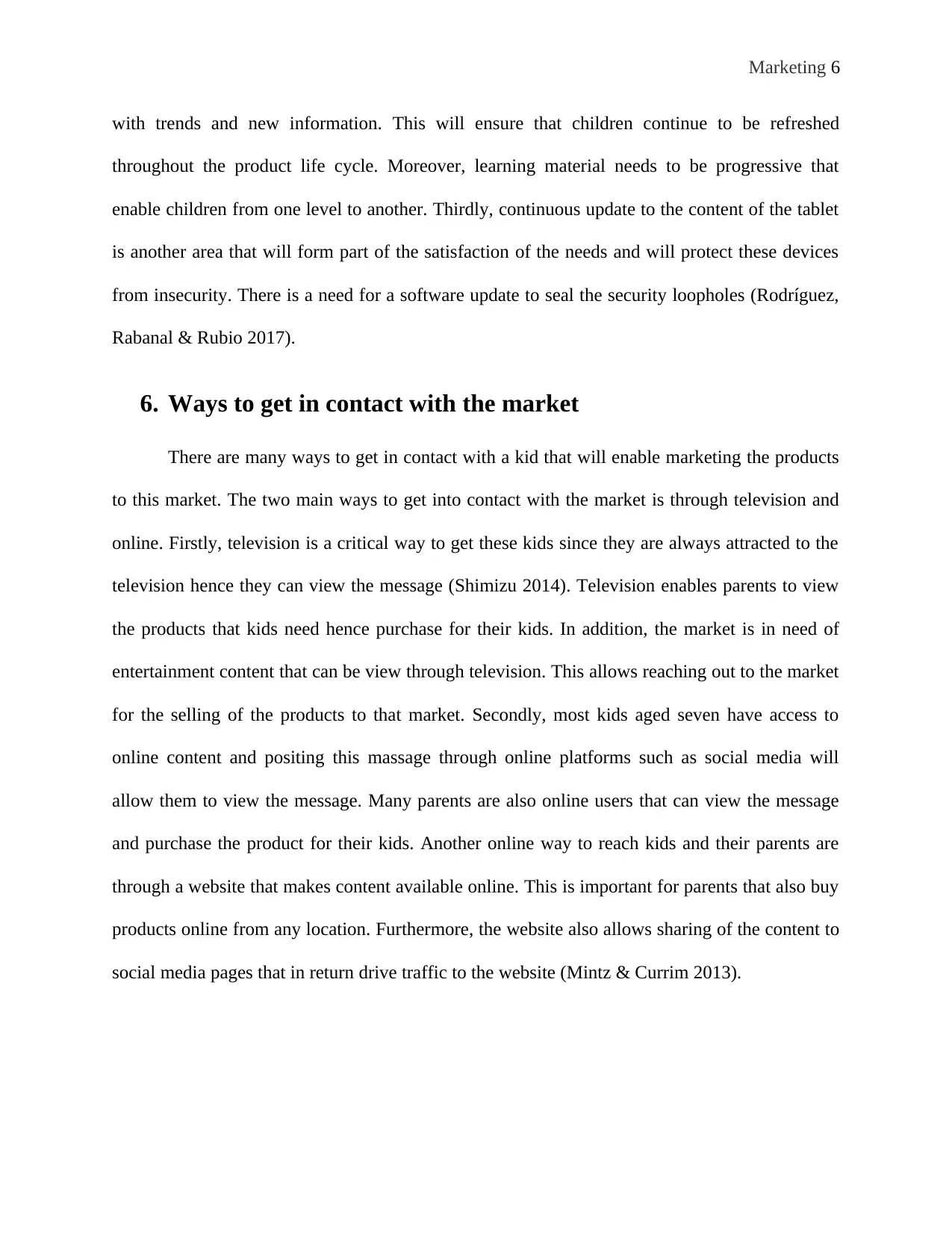
Marketing 6
with trends and new information. This will ensure that children continue to be refreshed
throughout the product life cycle. Moreover, learning material needs to be progressive that
enable children from one level to another. Thirdly, continuous update to the content of the tablet
is another area that will form part of the satisfaction of the needs and will protect these devices
from insecurity. There is a need for a software update to seal the security loopholes (Rodríguez,
Rabanal & Rubio 2017).
6. Ways to get in contact with the market
There are many ways to get in contact with a kid that will enable marketing the products
to this market. The two main ways to get into contact with the market is through television and
online. Firstly, television is a critical way to get these kids since they are always attracted to the
television hence they can view the message (Shimizu 2014). Television enables parents to view
the products that kids need hence purchase for their kids. In addition, the market is in need of
entertainment content that can be view through television. This allows reaching out to the market
for the selling of the products to that market. Secondly, most kids aged seven have access to
online content and positing this massage through online platforms such as social media will
allow them to view the message. Many parents are also online users that can view the message
and purchase the product for their kids. Another online way to reach kids and their parents are
through a website that makes content available online. This is important for parents that also buy
products online from any location. Furthermore, the website also allows sharing of the content to
social media pages that in return drive traffic to the website (Mintz & Currim 2013).
with trends and new information. This will ensure that children continue to be refreshed
throughout the product life cycle. Moreover, learning material needs to be progressive that
enable children from one level to another. Thirdly, continuous update to the content of the tablet
is another area that will form part of the satisfaction of the needs and will protect these devices
from insecurity. There is a need for a software update to seal the security loopholes (Rodríguez,
Rabanal & Rubio 2017).
6. Ways to get in contact with the market
There are many ways to get in contact with a kid that will enable marketing the products
to this market. The two main ways to get into contact with the market is through television and
online. Firstly, television is a critical way to get these kids since they are always attracted to the
television hence they can view the message (Shimizu 2014). Television enables parents to view
the products that kids need hence purchase for their kids. In addition, the market is in need of
entertainment content that can be view through television. This allows reaching out to the market
for the selling of the products to that market. Secondly, most kids aged seven have access to
online content and positing this massage through online platforms such as social media will
allow them to view the message. Many parents are also online users that can view the message
and purchase the product for their kids. Another online way to reach kids and their parents are
through a website that makes content available online. This is important for parents that also buy
products online from any location. Furthermore, the website also allows sharing of the content to
social media pages that in return drive traffic to the website (Mintz & Currim 2013).
⊘ This is a preview!⊘
Do you want full access?
Subscribe today to unlock all pages.

Trusted by 1+ million students worldwide
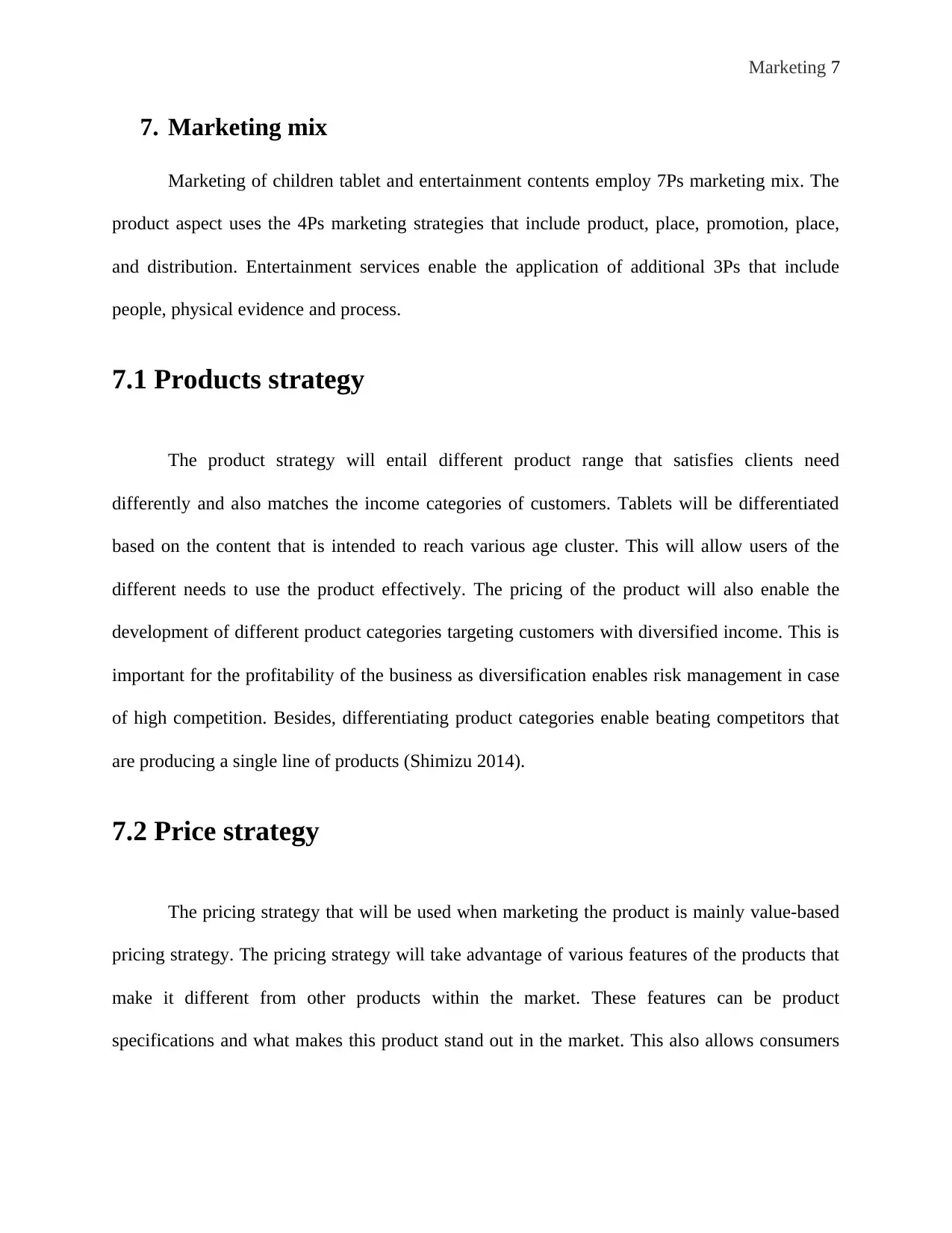
Marketing 7
7. Marketing mix
Marketing of children tablet and entertainment contents employ 7Ps marketing mix. The
product aspect uses the 4Ps marketing strategies that include product, place, promotion, place,
and distribution. Entertainment services enable the application of additional 3Ps that include
people, physical evidence and process.
7.1 Products strategy
The product strategy will entail different product range that satisfies clients need
differently and also matches the income categories of customers. Tablets will be differentiated
based on the content that is intended to reach various age cluster. This will allow users of the
different needs to use the product effectively. The pricing of the product will also enable the
development of different product categories targeting customers with diversified income. This is
important for the profitability of the business as diversification enables risk management in case
of high competition. Besides, differentiating product categories enable beating competitors that
are producing a single line of products (Shimizu 2014).
7.2 Price strategy
The pricing strategy that will be used when marketing the product is mainly value-based
pricing strategy. The pricing strategy will take advantage of various features of the products that
make it different from other products within the market. These features can be product
specifications and what makes this product stand out in the market. This also allows consumers
7. Marketing mix
Marketing of children tablet and entertainment contents employ 7Ps marketing mix. The
product aspect uses the 4Ps marketing strategies that include product, place, promotion, place,
and distribution. Entertainment services enable the application of additional 3Ps that include
people, physical evidence and process.
7.1 Products strategy
The product strategy will entail different product range that satisfies clients need
differently and also matches the income categories of customers. Tablets will be differentiated
based on the content that is intended to reach various age cluster. This will allow users of the
different needs to use the product effectively. The pricing of the product will also enable the
development of different product categories targeting customers with diversified income. This is
important for the profitability of the business as diversification enables risk management in case
of high competition. Besides, differentiating product categories enable beating competitors that
are producing a single line of products (Shimizu 2014).
7.2 Price strategy
The pricing strategy that will be used when marketing the product is mainly value-based
pricing strategy. The pricing strategy will take advantage of various features of the products that
make it different from other products within the market. These features can be product
specifications and what makes this product stand out in the market. This also allows consumers
Paraphrase This Document
Need a fresh take? Get an instant paraphrase of this document with our AI Paraphraser
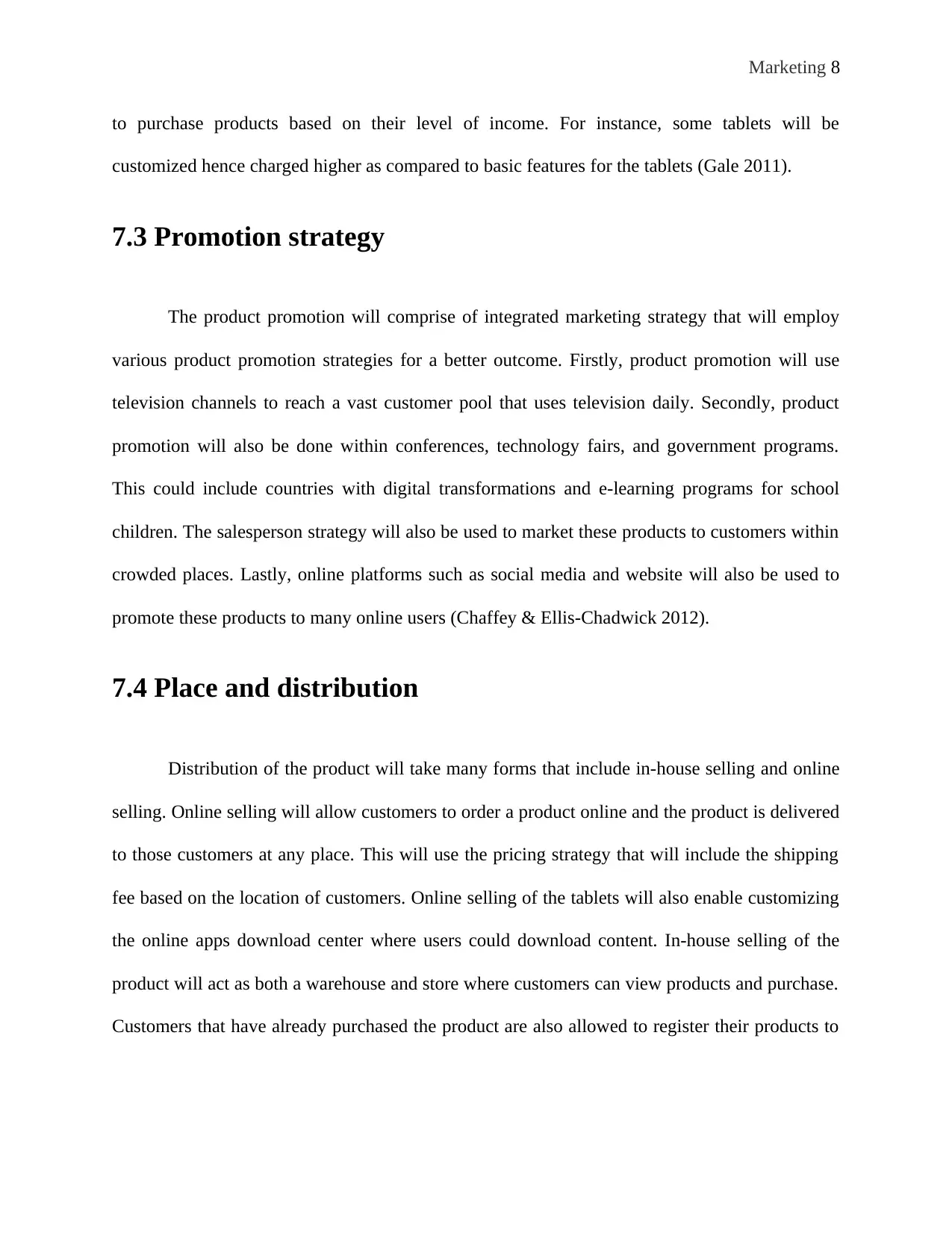
Marketing 8
to purchase products based on their level of income. For instance, some tablets will be
customized hence charged higher as compared to basic features for the tablets (Gale 2011).
7.3 Promotion strategy
The product promotion will comprise of integrated marketing strategy that will employ
various product promotion strategies for a better outcome. Firstly, product promotion will use
television channels to reach a vast customer pool that uses television daily. Secondly, product
promotion will also be done within conferences, technology fairs, and government programs.
This could include countries with digital transformations and e-learning programs for school
children. The salesperson strategy will also be used to market these products to customers within
crowded places. Lastly, online platforms such as social media and website will also be used to
promote these products to many online users (Chaffey & Ellis-Chadwick 2012).
7.4 Place and distribution
Distribution of the product will take many forms that include in-house selling and online
selling. Online selling will allow customers to order a product online and the product is delivered
to those customers at any place. This will use the pricing strategy that will include the shipping
fee based on the location of customers. Online selling of the tablets will also enable customizing
the online apps download center where users could download content. In-house selling of the
product will act as both a warehouse and store where customers can view products and purchase.
Customers that have already purchased the product are also allowed to register their products to
to purchase products based on their level of income. For instance, some tablets will be
customized hence charged higher as compared to basic features for the tablets (Gale 2011).
7.3 Promotion strategy
The product promotion will comprise of integrated marketing strategy that will employ
various product promotion strategies for a better outcome. Firstly, product promotion will use
television channels to reach a vast customer pool that uses television daily. Secondly, product
promotion will also be done within conferences, technology fairs, and government programs.
This could include countries with digital transformations and e-learning programs for school
children. The salesperson strategy will also be used to market these products to customers within
crowded places. Lastly, online platforms such as social media and website will also be used to
promote these products to many online users (Chaffey & Ellis-Chadwick 2012).
7.4 Place and distribution
Distribution of the product will take many forms that include in-house selling and online
selling. Online selling will allow customers to order a product online and the product is delivered
to those customers at any place. This will use the pricing strategy that will include the shipping
fee based on the location of customers. Online selling of the tablets will also enable customizing
the online apps download center where users could download content. In-house selling of the
product will act as both a warehouse and store where customers can view products and purchase.
Customers that have already purchased the product are also allowed to register their products to
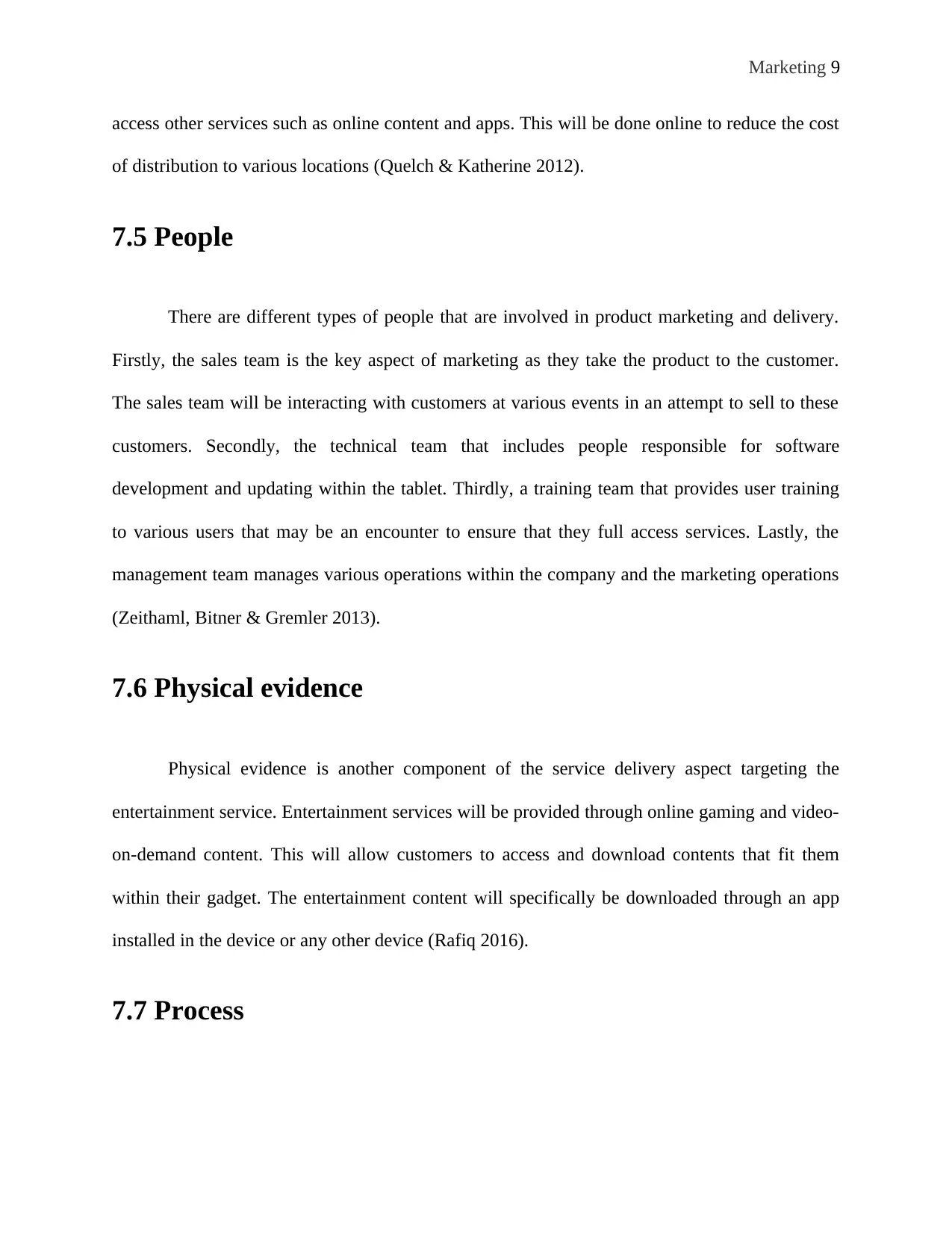
Marketing 9
access other services such as online content and apps. This will be done online to reduce the cost
of distribution to various locations (Quelch & Katherine 2012).
7.5 People
There are different types of people that are involved in product marketing and delivery.
Firstly, the sales team is the key aspect of marketing as they take the product to the customer.
The sales team will be interacting with customers at various events in an attempt to sell to these
customers. Secondly, the technical team that includes people responsible for software
development and updating within the tablet. Thirdly, a training team that provides user training
to various users that may be an encounter to ensure that they full access services. Lastly, the
management team manages various operations within the company and the marketing operations
(Zeithaml, Bitner & Gremler 2013).
7.6 Physical evidence
Physical evidence is another component of the service delivery aspect targeting the
entertainment service. Entertainment services will be provided through online gaming and video-
on-demand content. This will allow customers to access and download contents that fit them
within their gadget. The entertainment content will specifically be downloaded through an app
installed in the device or any other device (Rafiq 2016).
7.7 Process
access other services such as online content and apps. This will be done online to reduce the cost
of distribution to various locations (Quelch & Katherine 2012).
7.5 People
There are different types of people that are involved in product marketing and delivery.
Firstly, the sales team is the key aspect of marketing as they take the product to the customer.
The sales team will be interacting with customers at various events in an attempt to sell to these
customers. Secondly, the technical team that includes people responsible for software
development and updating within the tablet. Thirdly, a training team that provides user training
to various users that may be an encounter to ensure that they full access services. Lastly, the
management team manages various operations within the company and the marketing operations
(Zeithaml, Bitner & Gremler 2013).
7.6 Physical evidence
Physical evidence is another component of the service delivery aspect targeting the
entertainment service. Entertainment services will be provided through online gaming and video-
on-demand content. This will allow customers to access and download contents that fit them
within their gadget. The entertainment content will specifically be downloaded through an app
installed in the device or any other device (Rafiq 2016).
7.7 Process
⊘ This is a preview!⊘
Do you want full access?
Subscribe today to unlock all pages.

Trusted by 1+ million students worldwide
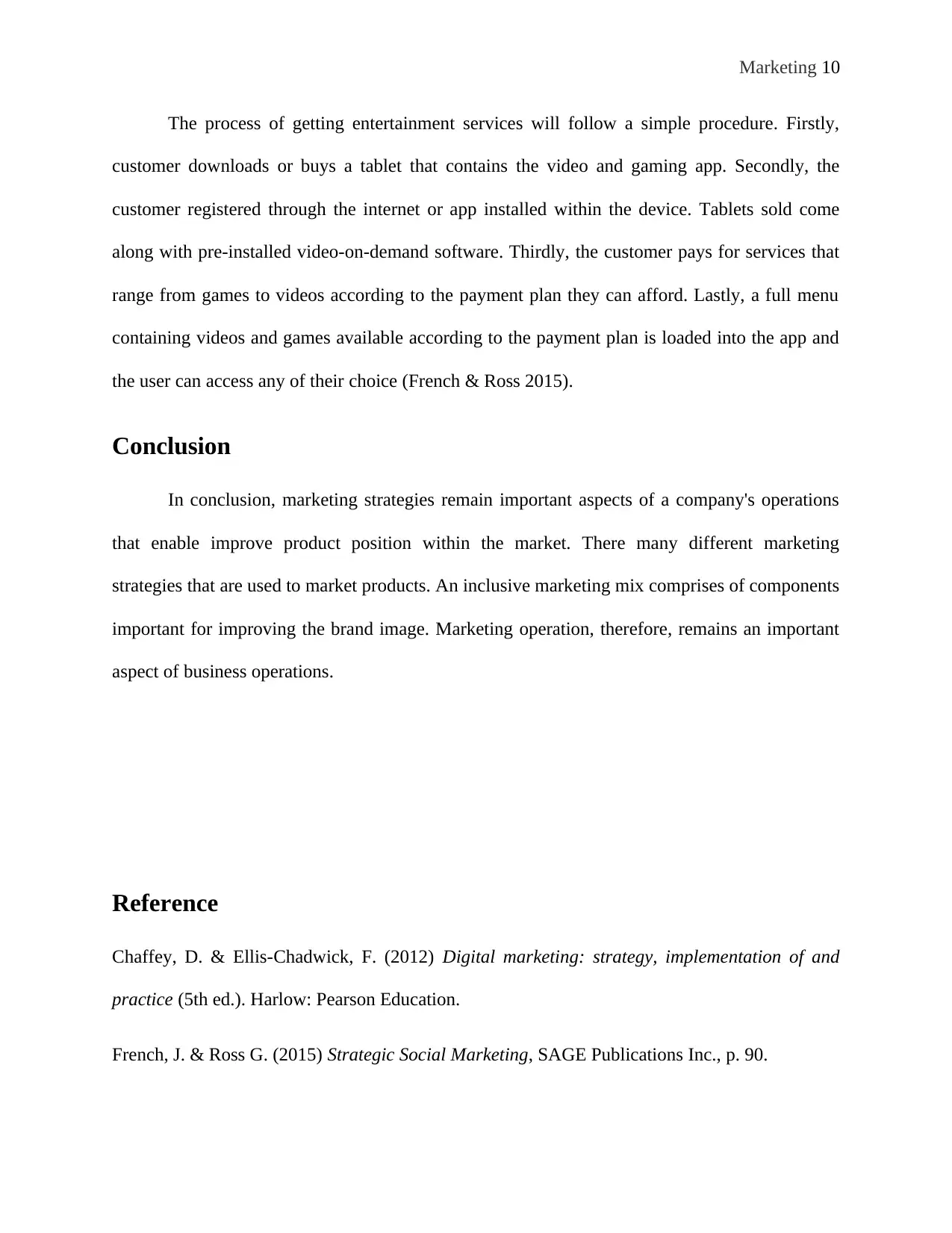
Marketing 10
The process of getting entertainment services will follow a simple procedure. Firstly,
customer downloads or buys a tablet that contains the video and gaming app. Secondly, the
customer registered through the internet or app installed within the device. Tablets sold come
along with pre-installed video-on-demand software. Thirdly, the customer pays for services that
range from games to videos according to the payment plan they can afford. Lastly, a full menu
containing videos and games available according to the payment plan is loaded into the app and
the user can access any of their choice (French & Ross 2015).
Conclusion
In conclusion, marketing strategies remain important aspects of a company's operations
that enable improve product position within the market. There many different marketing
strategies that are used to market products. An inclusive marketing mix comprises of components
important for improving the brand image. Marketing operation, therefore, remains an important
aspect of business operations.
Reference
Chaffey, D. & Ellis-Chadwick, F. (2012) Digital marketing: strategy, implementation of and
practice (5th ed.). Harlow: Pearson Education.
French, J. & Ross G. (2015) Strategic Social Marketing, SAGE Publications Inc., p. 90.
The process of getting entertainment services will follow a simple procedure. Firstly,
customer downloads or buys a tablet that contains the video and gaming app. Secondly, the
customer registered through the internet or app installed within the device. Tablets sold come
along with pre-installed video-on-demand software. Thirdly, the customer pays for services that
range from games to videos according to the payment plan they can afford. Lastly, a full menu
containing videos and games available according to the payment plan is loaded into the app and
the user can access any of their choice (French & Ross 2015).
Conclusion
In conclusion, marketing strategies remain important aspects of a company's operations
that enable improve product position within the market. There many different marketing
strategies that are used to market products. An inclusive marketing mix comprises of components
important for improving the brand image. Marketing operation, therefore, remains an important
aspect of business operations.
Reference
Chaffey, D. & Ellis-Chadwick, F. (2012) Digital marketing: strategy, implementation of and
practice (5th ed.). Harlow: Pearson Education.
French, J. & Ross G. (2015) Strategic Social Marketing, SAGE Publications Inc., p. 90.
Paraphrase This Document
Need a fresh take? Get an instant paraphrase of this document with our AI Paraphraser
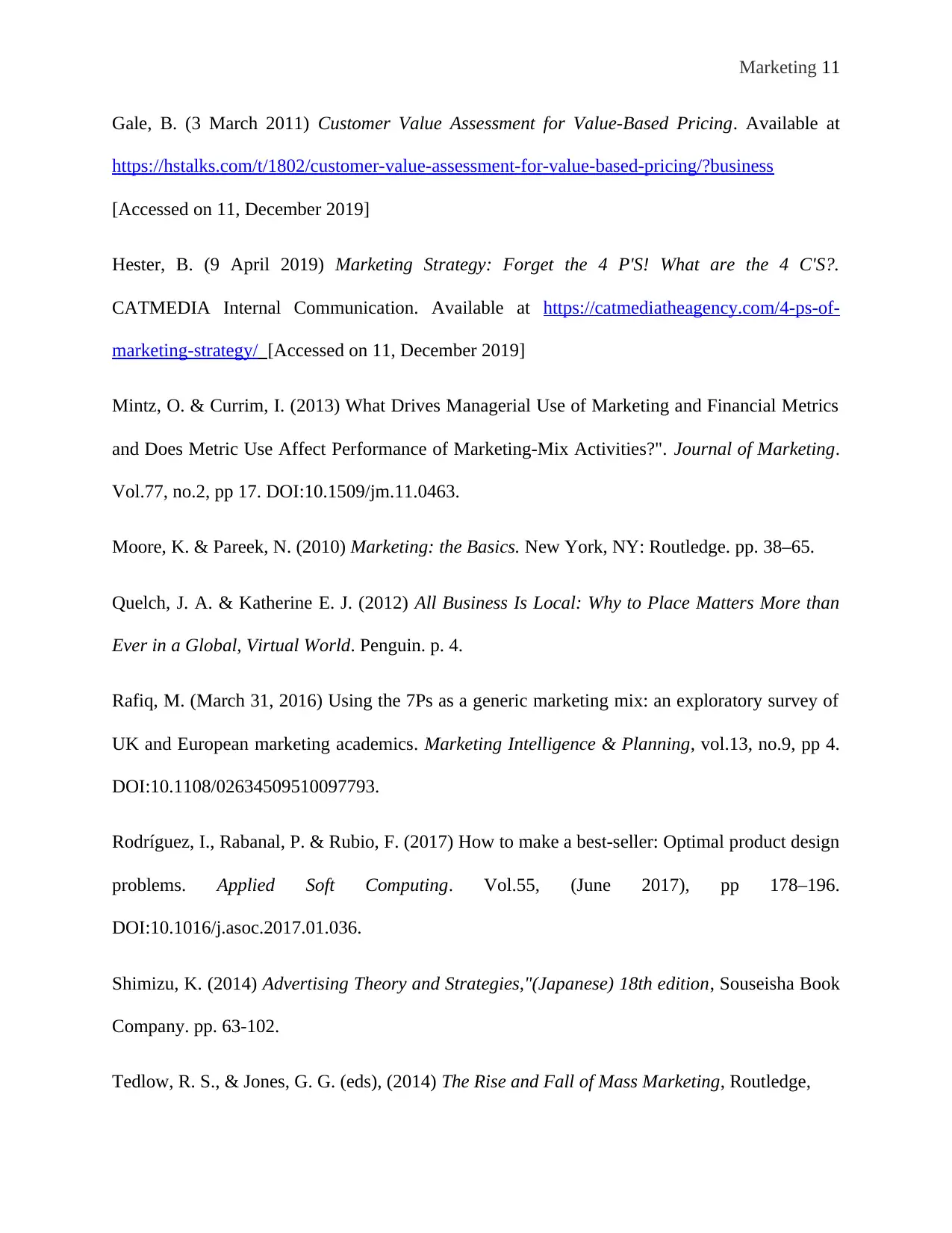
Marketing 11
Gale, B. (3 March 2011) Customer Value Assessment for Value-Based Pricing. Available at
https://hstalks.com/t/1802/customer-value-assessment-for-value-based-pricing/?business
[Accessed on 11, December 2019]
Hester, B. (9 April 2019) Marketing Strategy: Forget the 4 P'S! What are the 4 C'S?.
CATMEDIA Internal Communication. Available at https://catmediatheagency.com/4-ps-of-
marketing-strategy/ [Accessed on 11, December 2019]
Mintz, O. & Currim, I. (2013) What Drives Managerial Use of Marketing and Financial Metrics
and Does Metric Use Affect Performance of Marketing-Mix Activities?". Journal of Marketing.
Vol.77, no.2, pp 17. DOI:10.1509/jm.11.0463.
Moore, K. & Pareek, N. (2010) Marketing: the Basics. New York, NY: Routledge. pp. 38–65.
Quelch, J. A. & Katherine E. J. (2012) All Business Is Local: Why to Place Matters More than
Ever in a Global, Virtual World. Penguin. p. 4.
Rafiq, M. (March 31, 2016) Using the 7Ps as a generic marketing mix: an exploratory survey of
UK and European marketing academics. Marketing Intelligence & Planning, vol.13, no.9, pp 4.
DOI:10.1108/02634509510097793.
Rodríguez, I., Rabanal, P. & Rubio, F. (2017) How to make a best-seller: Optimal product design
problems. Applied Soft Computing. Vol.55, (June 2017), pp 178–196.
DOI:10.1016/j.asoc.2017.01.036.
Shimizu, K. (2014) Advertising Theory and Strategies,"(Japanese) 18th edition, Souseisha Book
Company. pp. 63-102.
Tedlow, R. S., & Jones, G. G. (eds), (2014) The Rise and Fall of Mass Marketing, Routledge,
Gale, B. (3 March 2011) Customer Value Assessment for Value-Based Pricing. Available at
https://hstalks.com/t/1802/customer-value-assessment-for-value-based-pricing/?business
[Accessed on 11, December 2019]
Hester, B. (9 April 2019) Marketing Strategy: Forget the 4 P'S! What are the 4 C'S?.
CATMEDIA Internal Communication. Available at https://catmediatheagency.com/4-ps-of-
marketing-strategy/ [Accessed on 11, December 2019]
Mintz, O. & Currim, I. (2013) What Drives Managerial Use of Marketing and Financial Metrics
and Does Metric Use Affect Performance of Marketing-Mix Activities?". Journal of Marketing.
Vol.77, no.2, pp 17. DOI:10.1509/jm.11.0463.
Moore, K. & Pareek, N. (2010) Marketing: the Basics. New York, NY: Routledge. pp. 38–65.
Quelch, J. A. & Katherine E. J. (2012) All Business Is Local: Why to Place Matters More than
Ever in a Global, Virtual World. Penguin. p. 4.
Rafiq, M. (March 31, 2016) Using the 7Ps as a generic marketing mix: an exploratory survey of
UK and European marketing academics. Marketing Intelligence & Planning, vol.13, no.9, pp 4.
DOI:10.1108/02634509510097793.
Rodríguez, I., Rabanal, P. & Rubio, F. (2017) How to make a best-seller: Optimal product design
problems. Applied Soft Computing. Vol.55, (June 2017), pp 178–196.
DOI:10.1016/j.asoc.2017.01.036.
Shimizu, K. (2014) Advertising Theory and Strategies,"(Japanese) 18th edition, Souseisha Book
Company. pp. 63-102.
Tedlow, R. S., & Jones, G. G. (eds), (2014) The Rise and Fall of Mass Marketing, Routledge,

Marketing 12
Zeithaml, V. Bitner, M.J. & Gremler, D.D., (2013) Services Marketing: Integrating Customer
Focus Across the Firm, (6th ed), New York: McGraw-Hill.
Zeithaml, V. Bitner, M.J. & Gremler, D.D., (2013) Services Marketing: Integrating Customer
Focus Across the Firm, (6th ed), New York: McGraw-Hill.
⊘ This is a preview!⊘
Do you want full access?
Subscribe today to unlock all pages.

Trusted by 1+ million students worldwide
1 out of 12
Related Documents
Your All-in-One AI-Powered Toolkit for Academic Success.
+13062052269
info@desklib.com
Available 24*7 on WhatsApp / Email
![[object Object]](/_next/static/media/star-bottom.7253800d.svg)
Unlock your academic potential
Copyright © 2020–2025 A2Z Services. All Rights Reserved. Developed and managed by ZUCOL.





